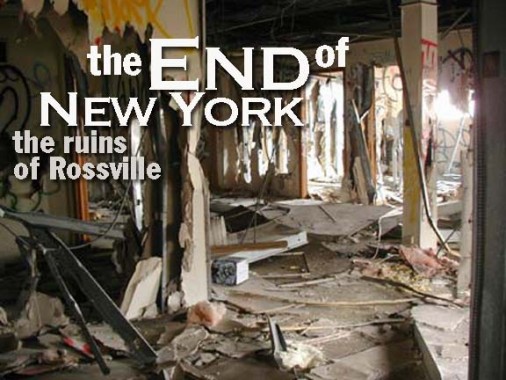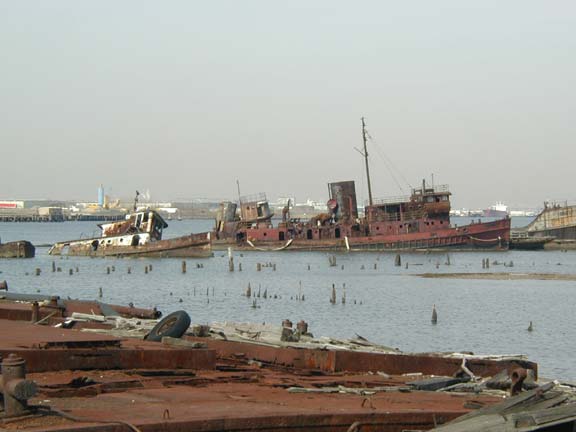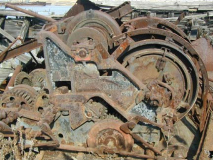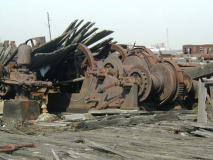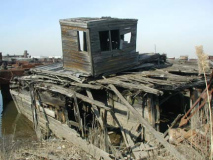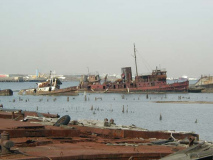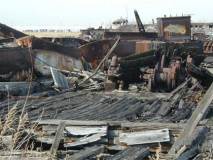In my NYC travels, I am occasionally drawn to untrammeled, ruined places that are awaiting renovation or demolition; only when witnessing such desolation, it seems, can I truly appreciate the revitalization that is otherwise going on in the city in this post-9/11 era (and who knows how long before we’ll be talking about another day of infamy).
In March, another fellow NYC traveler of ruins, Andrew N. of Urban Exploration Files, visited Rossville, Staten Island, which seemingly preserves its wrecks like no other neighborhood in the city I’ve yet seen. Truly, this is the literal (it’s near the southernmost edge of Staten Island) and figurative end of New York City.
Named for a local wealthy 18th Century landowner, William Ross, the small town was known before the Revolution by the picturesque name Blazing Star. Ferries, and later steamships whose wrecks are still sinking in the Arthur Kill, connected it with New Jersey. After the West Shore Expressway was built in the 1970s, it spurred development south of the highway, with street after street filled with what songwriter Malvina Reynolds and folksinger Pete Seeger would call “little boxes made of ticky tacky that all look just the same.” North of the expressway are shipwrecks, auto repair shops, abandoned cemeteries, and assorted detritus that has been there for decades and may last decades more.
The Rossville Boatyard
Vessels from all decades of the 20th Century lie, not exactly in state, but in a state of decomposition and rust at this former boatyard at Arthur Kill Road and Rossville Avenue. Most are tugs or cargo ships. The former piers have collapsed and are for the most part impassible, which makes them a magnet for daredevil urban explorers.
Andrew has related the difficulties of getting decent pictures of the Boatyard. At low tide you can stroll quite close to the ships, actually, but the sand is loose and can obtain a quicksand-like quality; you run the risk of getting stuck for quite awhile while the tide rushes back in. The Boatyard is about a football field’s length from Arthur Kill Road, which juts toward its namesake inlet at this point, but it would be rather hard for anyone to hear you.
Two wooden tugs poke their prows above the waterline. Even more spectacular shipwrecks await those brave enough to clamber across the piers and get closer to them.
By far the most spectacular, and up-close, photos of these derelict, ghost vessels has been made by a photographer named Shawn O’Boyle. Shawn’s spectacular renderings can be viewed here.
The woods between Arthur Kill Road and the Arthur Kill are thick with abandoned vehicles, many from the early-1980s and earlier. New Jersey hasn’t used this style license plate for a number of years.
Near the Boatyard and the dead cars, you’ll find some dead people in the truly ancient roadside Blazing Star Burial Ground.
Mind your orthography. Before figures like Samuel Johnson and Noah Webster showed up on the scene, you pretty much spelled a word the way you wanted. At this time, proper names were similarly variable in spelling, with family members spelling their surnames in different ways. On the stone at left, you see Marshel while on adjacent stones, it’s spelled Marshall. In the 1750s the ‘long s’ was still used; ‘s’ appearing in the middle of a word was written and printed as a “tall” version of the small ‘s’. This pretty much disappeared by the 1780s or 1790s. In today’s German blackletter, you can see a remnant of this as the double S has a symbol with the two ‘s’s connected at the top which rather resembles a pair of old ‘long s’s’, or a capital B, depending on the font. In printed documents from this time, the ‘long s’ was fashioned in cold type from the lower case f with the ‘f’s crossbar filled in, so these long ‘s’s often looked like ‘f’s. It’s all in the context.
These are the oldest stones we found in the cemetery, each from the 1750s, but the cemetery is probably decades older than that.
In the era of stagecoach travel, what is now Arthur Kill Road was a toll road. A tollbooth stood at the present road where it meets Rossville Avenue. It was remodeled and moved to nearby Poplar Avenue. To serve stagecoach traffic, many roadside taverns and inns (like the remaining one here) were built. Some, like the Old Bermuda Inn built in 1814, are reputed to be haunted.
The Rossville skyline is dominated by two huge tanks, no longer filled with gas, surrounded by a weed-strewn expanse dotted with rusted trucks and graffiti-pocked buildings. This truck has an old Western Electric logo on it.
Signage here has been long-neglected and now completely graffiti-coated. This truck gained my notice because it appeared, at first, to be an old trolley car. On further inspection, it seems to be a truck used to transport horses.
This large, ruined building near the tanks now exists only as a testing canvas for local graffitists, who lovingly leave their brushes and palettes on the ground near the wall in tribute. Or perhaps in haste when sirens are heard and flashlights are spotted.
St. Luke’s Cemetery
This cemetery is wedged between the Tanks and the auto body shops on the seemingly unending Arthur Kill Road. Sleights, Deckers and other native Staten Island families are predominant on the tombstones. There are a very few 18th Century stones here, but most date to the 1850s and after. At left, a prankster broke off the top of a stone and wedged it between the rest of the stone and a tree, which grew around it. This cemetery is larger than Blazing Star Burying Ground and is in better shape.
The Pipe Factory
Between the Tanks and a “correctional facility” (a prison, with miles of barbed wire along its fenced exterior; the S74 bus makes frequent stops) is, or was, the James H. Merritt Piping Contractor.
Here play out scenes of poignant urban abandonment and rude reminders that…thou art dust.
In 2005 the Pipe Factory was razed.
Staten Island in particular is home to overgrown, abandoned acreage. The center of the island features the old Seaview Hospital and Farm Colony; near Wagner College is a long-abandoned retreat house (your webmaster attended a 3-day session here) now assumed to be haunted, but not by me.
There’s another old cemetery on Barry Street; apparently it is relatively new, containing no stones older than the mid-1850s. For me, its drawing card is a series of crude, hand-lettered stones with a language that stumps me. Hungarian, perhaps? Yet another cemetery is near, on Crabtree Avenue in Sandy Ground.
Your webmaster photographed this page on March 1, 2004 and completed its composition on March 27, 2004.
